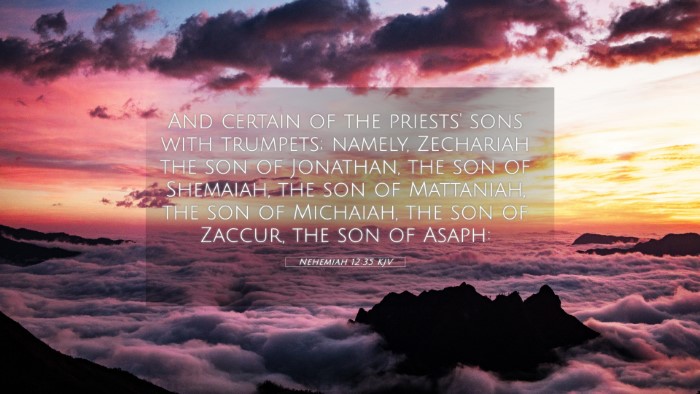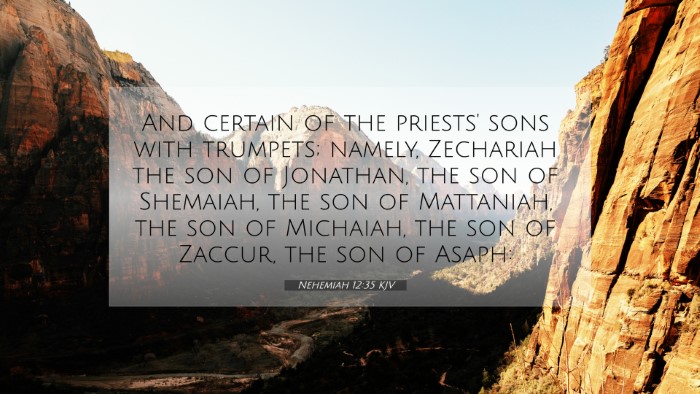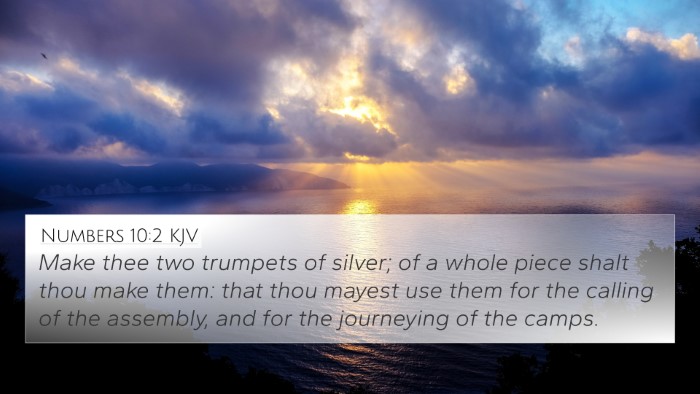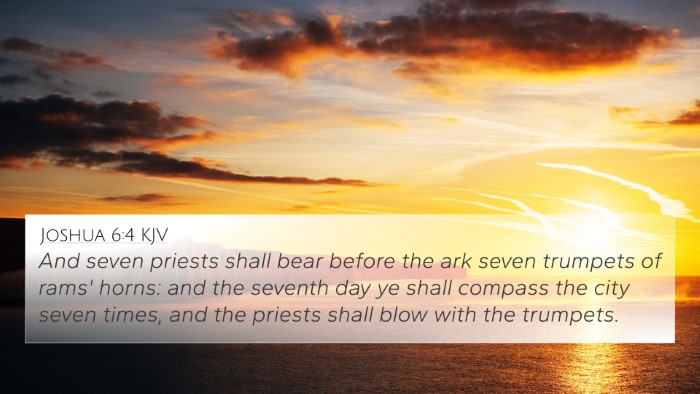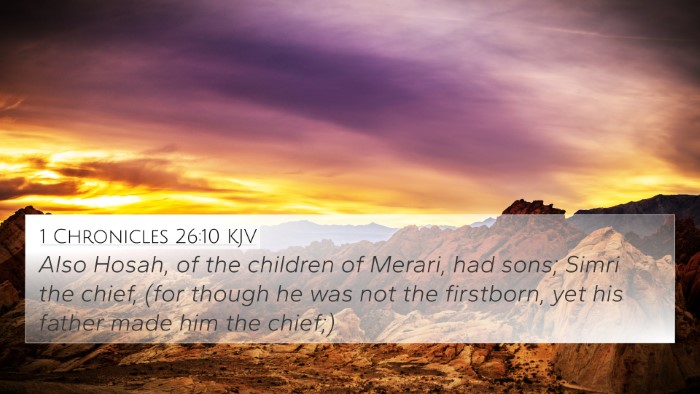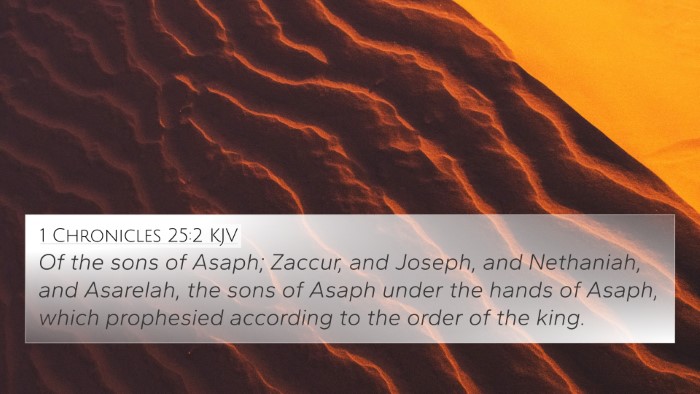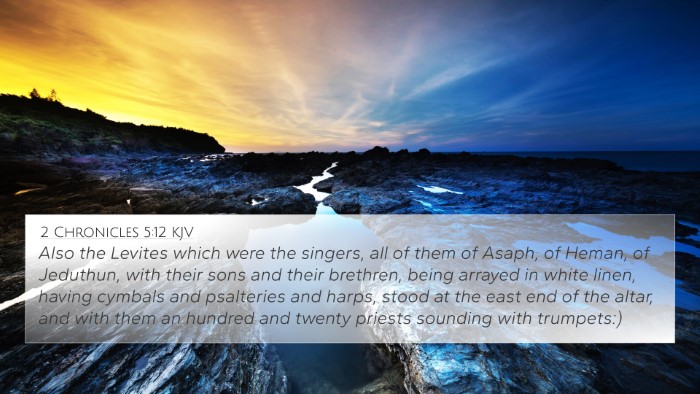Understanding Nehemiah 12:35
Verse: Nehemiah 12:35 - "And certain of the priests' sons with trumpets; namely, Zechariah the son of Jonathan, the son of Shemaiah, the son of Mattaniah, the son of Michaiah, the son of Zaccur, the son of Asaph."
Verse Meaning and Interpretation
This passage from Nehemiah highlights the reestablishment of proper worship and the organization of temple services after the return from exile. The mention of the priests’ sons playing trumpets suggests an important role in the worship and ceremonial activities of the Israelites. Below are interpretations combining insights from public domain commentaries.
Insights from Commentaries
-
Matthew Henry:
Henry emphasizes the significance of musical instruments in worship, particularly trumpets, which were used to call people to assembly and signal major events. In the context of Nehemiah, these priests' sons serving with trumpets symbolize a return to God-centered worship and the restoration of the community's identity.
-
Albert Barnes:
Barnes notes the specific lineage of the trumpet players, which reflects the importance of priestly heritage in temple service. The precision in naming these descendants underscores the acknowledgment of God's order and the restoration of rituals that honor Him. This also connects the worship practices back to the instructions given in the Pentateuch.
-
Adam Clarke:
Clarke points out that the roles assigned to the priests’ sons symbolize the transmission of responsibility and prestige within the priestly families. This not only reaffirms their service but also illustrates a reestablished community structure that is essential for worship and celebration in post-exilic Israel.
Cross-References and Thematic Connections
Nehemiah 12:35 may be understood more profoundly when cross-referenced with other scriptural passages. Here are several connections between Bible verses that relate to Nehemiah 12:35:
- Numbers 10:8: This verse describes the sons of Aaron, the priests, using trumpets for calling the congregation, which establishes a direct link to the practices reinstituted in Nehemiah's time.
- 1 Chronicles 16:6: This passage emphasizes the role of Asaph and his descendants in the worship music, paralleling the family line of the priests' sons mentioned in Nehemiah.
- Psalms 150:3-5: These verses call for praising God with trumpets and other instruments, showcasing the continuity of musical worship throughout the Scriptures.
- Ezra 3:10-11: The foundation of the second temple was laid, and the priests and Levites sang, representing early phases of restored worship after exile.
- 2 Chronicles 5:12-13: Here, trumpets were used during the dedication of the temple, affirming the importance of these instruments in worship settings.
- Zechariah 10:3: This passage speaks of God appointing leaders and connecting them with the line of Levites, similar to how priestly roles are established in Nehemiah.
- Hebrews 7:14: This verse mentions Jesus as springing from Judah, contrasting the Aaronic priesthood with the new order, highlighting the shift in priestly focus.
- 1 Corinthians 14:8: The sound of a trumpet is used as an analogy for clarity in communication, analogous to the clarity needed in worship settings.
- Matthew 24:31: Here, the mention of angels gathering the elect with a trumpet reinforces the significance of trumpets in biblical theology.
- Acts 2:1-4: The sound of a rushing wind during Pentecost can be seen as a thematic parallel to the use of sound in worship and gatherings, connecting the Old and New Testament practices.
Applications and Themes
This verse and its connections illustrate several overarching themes that transcend the historical context of Nehemiah:
- Restoration of Worship: The return to Jerusalem and the emphasis on organized worship signify a reclamation of identity and community for the Israelites.
- Musical Expression in Worship: The use of trumpets and other instruments represents not only a form of praise but also the joy and celebration of God’s faithfulness.
- Heritage and Lineage: The mention of specific family lines emphasizes the importance of heritage in ministry and worship roles, crucial for understanding priestly duties.
- God’s Order: The specifics surrounding roles and responsibilities reveal God’s desire for order and structure within religious practices.
Conclusion
Nehemiah 12:35 serves as a reminder of the significance of worship and the restoration of holy practices among God's people. By employing tools for Bible cross-referencing, readers can connect this passage to a broader biblical narrative that showcases the continuity of worship, God's faithfulness, and the essential roles played by individuals within the community. Understanding these connections will enhance one’s biblical study and deepen the appreciation for the intricate design of God’s word.

